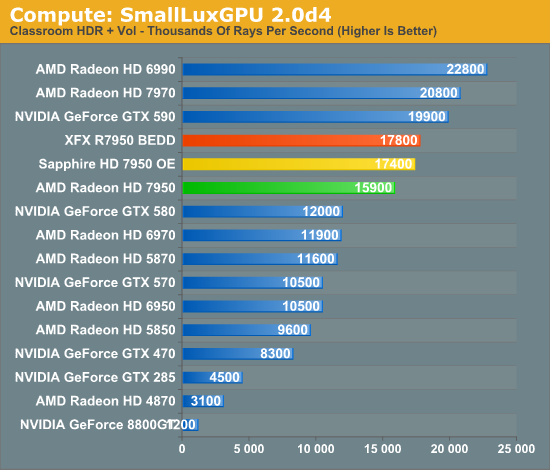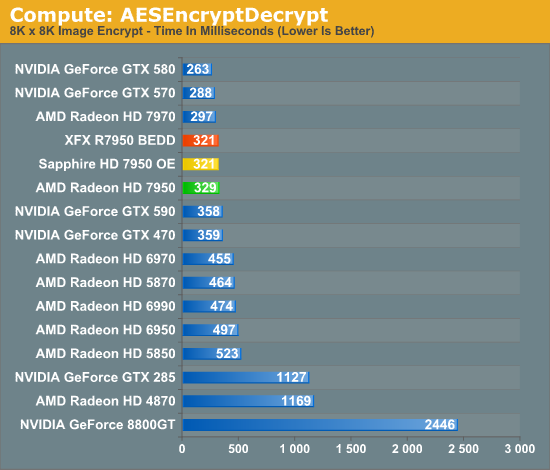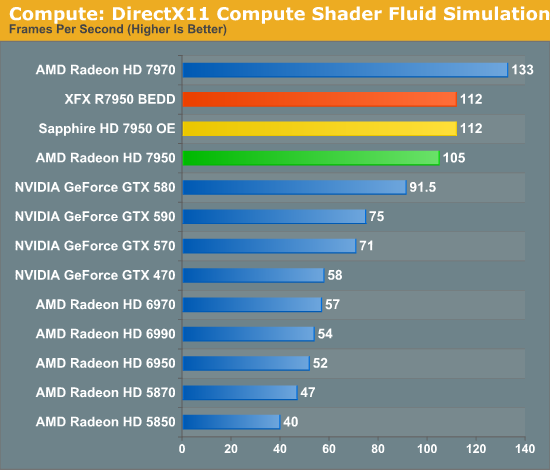AMD Radeon HD 7950 Review Feat. Sapphire & XFX: Sewing Up The High-End Market
by Ryan Smith on January 31, 2012 9:02 AM ESTCompute Performance
Moving on from our look at gaming performance, we have our customary look at compute performance. Since compute performance is by definition shader bound, the 7950 is at a bit of a disadvantage here compared to gaming performance. Whereas ROP performance scales with the core clock, shader performance is hit by both the reduction in the core clock and the disabled CU array.
Our first compute benchmark comes from Civilization V, which uses DirectCompute to decompress textures on the fly. Civ V includes a sub-benchmark that exclusively tests the speed of their texture decompression algorithm by repeatedly decompressing the textures required for one of the game’s leader scenes. Note that this is a DX11 DirectCompute benchmark.

AMD’s greatly improved compute performance continues to shine here, though in the case of Civilization V it’s largely consumed by just closing the previously large gap between the GTX 500 series and the Radeon HD 6000 series. As a result the 7950 falls ever so short of the GTX 580, while the factory overclocked Sapphire and XFX cards give the 7950 enough of a push to come within 5% of the 7970.
Our next benchmark is SmallLuxGPU, the GPU ray tracing branch of the open source LuxRender renderer. We’re now using a development build from the version 2.0 branch, and we’ve moved on to a more complex scene that hopefully will provide a greater challenge to our GPUs.

Under SmallLuxGPU the 7970 enjoyed a large lead over the GTX 580, and this continues with the 7950. Even though the 7950 is well behind the 7970—to the tune of 24%—it’s still 33% ahead of the GTX 580 and the lead only grows from there. Meanwhile the XFX and Sapphire cards can catch up to the 7970 somewhat, but as this is truly a shader-bound test, you can’t make up for the lack of shaders units on the 7950.
For our next benchmark we’re looking at AESEncryptDecrypt, an OpenCL AES encryption routine that AES encrypts/decrypts an 8K x 8K pixel square image file. The results of this benchmark are the average time to encrypt the image over a number of iterations of the AES cypher.

In spite of being a compute benchmark, AESEncryptDecrypt is not particularly sensitive to GPU performance, showcasing the impact that setup times can have. The 7950 trails the 7970 by 10%, and overclocking doesn’t change this much. Unfortunately for AMD NVIDIA is still the leader here, showing that AMD’s compute performance still has room to grow.
Finally, our last benchmark is once again looking at compute shader performance, this time through the Fluid simulation sample in the DirectX SDK. This program simulates the motion and interactions of a 16k particle fluid using a compute shader, with a choice of several different algorithms. In this case we’re using an (O)n^2 nearest neighbor method that is optimized by using shared memory to cache data.

With the compute shader fluid simulation we once again shift back into a compute task that’s much more shader-bound. The 7950 only reaches 80% of the performance of the 7970, once more proving the real impact of losing a CU array. This is still enough to handily surpass the GTX 580 however, with the 7950 taking a 15% lead.










259 Comments
View All Comments
Ryan Smith - Tuesday, January 31, 2012 - link
Correct. That's BIOS 015.013.000.010.000705Ryan Smith - Tuesday, January 31, 2012 - link
I should add that this is also the build number of the BIOS on Sapphire's card.AnandThenMan - Tuesday, January 31, 2012 - link
Thanks for the info, appreciated.Sttm - Tuesday, January 31, 2012 - link
There is 0 chance these retarded prices will remain past Nvidia's next gen launch. At that point the 7950 will drop below $300 to be competitive. So if you pay $450 now, you are a chump.mdlam - Tuesday, January 31, 2012 - link
NO....maybe its because you just want the best card. just like all the other "chumps" were paying 500 for a gtx580 or still are, which is a completely disproportionately unfavorable price/performance ratio compared to the 560ti/6950 unlocked.rronald1 - Tuesday, January 31, 2012 - link
I was hoping for $300-350 price tag for 7950.Right now it´s much better to get 2x second hand 6970 running in crossfire, you will get better performances than even 7970 or even 6990.
But we all know the price will drops like stones once Kepler hits the market.
mdlam - Tuesday, January 31, 2012 - link
Only if Kepler isn't a total fail like FermiEugene86 - Tuesday, January 31, 2012 - link
Except Fermi wasn't a fail...artk2219 - Wednesday, February 1, 2012 - link
The original Fermi could most definitely count as a fail, hot loud, power hungry, big, expensive for only 20% more power than a 5870, and LATE, it was fun to watch :). It wasn't until the 460 and the release of the 500 series that Nvidia got that mess worked out.Veroxious - Tuesday, January 31, 2012 - link
While the performance is impressive, the pricing is just ridiculous and leaves a bittter taste in the mouth. One could get similar performance from 2 x 6850 /2 x gtx460's for $320-360.For my next upgrade I was looking for slightly more horsepower than a single gtx580 combined with Ivy bridge. Ofcourse 1st prize for me is a single powerful gpu as opposed to sli/crossfire but at $450 for a reference card it's just pointless. We'll see what happens with Kepler but it seems AMD is setting a recurring trend of increased base cost for every architectural generation which means the costs just keep escalating. What was once a small caliber hole in my pocket seems to have become a 12-gauge crater. Arrrghhhh.........